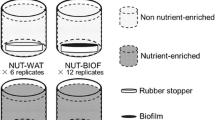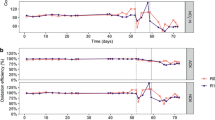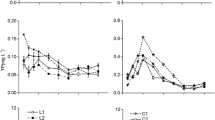Abstract
Biofilms play important roles in nutrients and energy cycling in aquatic ecosystems. We hypothesized that as eutrophication could change phytoplankton community and decrease phytoplankton diversity, ambient inorganic nitrogen level will affect the microbial community and diversity of biofilms and the roles of biofilms in nutrient cycling. Biofilms were cultured using a flow incubator either with replete inorganic nitrogen (N-rep) or without exogenous inorganic nitrogen supply (N-def). The results showed that the biomass and nitrogen and phosphorous accumulation of biofilms were limited by N deficiency; however, as expected, the N-def biofilms had significantly higher microbial diversity than that of N-rep biofilms. The microbial community of biofilms shifted in composition and abundance in response to ambient inorganic nitrogen level. For example, as compared between the N-def and the N-rep biofilms, the former consisted of more diazotrophs, while the latter consisted of more denitrifying bacteria. As a result of the shift of the functional microbial community, the N concentration of N-rep medium kept decreasing, while that of N-def medium showed an increasing trend in the late stage. This indicates that biofilms can serve as the source or the sink of nitrogen in aquatic ecosystems, and it depends on the inorganic nitrogen availability.










Similar content being viewed by others
References
Di Pippo F, Bohn A, Congestri R, De Philippis R, Albertano P (2009) Capsular polysaccharides of cultured phototrophic biofilms. Biofouling 25(6):495–504
Lock M, Wallace R, Costerton J, Ventullo R, Charlton S (1984) River epilithon: toward a structural-functional model. Oikos 42(1):10–22
Battin TJ, Kaplan LA, Newbold JD, Hansen CM (2003) Contributions of microbial biofilms to ecosystem processes in stream mesocosms. Nature 426(6965):439–442
Guzzon A, Bohn A, Diociaiuti M, Albertano P (2008a) Cultured phototrophic biofilms for phosphorus removal in wastewater treatment. Water Res. 42(16):4357–4367
Chávez-Crooker P, Obreque-Contreras J (2010) Bioremediation of aquaculture wastes. Curr. Opin. Biotechnol. 21(3):313–317
Bender J, Phillips P (2004) Microbial mats for multiple applications in aquaculture and bioremediation. Bioresour. Technol. 94(3):229–238
Schumacher G, Blume T, Sekoulov I (2003) Bacteria reduction and nutrient removal in small wastewater treatment plants by an algal biofilm. Water Sci. Technol. 47(11):195–202
Vymazal J, Sldeek V, Stach J (2001) Biota participating in wastewater treatment in a horizontal flow constructed wetland. Water Sci. Technol. 44(11–12):211–214
Bhadury P, Wright PC (2004) Exploitation of marine algae: biogenic compounds for potential antifouling applications. Planta 219(4):561–578
Patil JS, Anil AC (2005) Biofilm diatom community structure: influence of temporal and substratum variability. Biofouling 21(3–4):189–206
Yang C, Chen H, Zeng G, Yu G, Luo S (2010) Biomass accumulation and control strategies in gas biofiltration. Biotechnol. Adv. 28(4):531–540
Gruber N, Galloway JN (2008) An earth-system perspective of the global nitrogen cycle. Nature 451(7176):293–296
Francis CA, Beman JM, Kuypers MM (2007) New processes and players in the nitrogen cycle: the microbial ecology of anaerobic and archaeal ammonia oxidation. ISME J 1(1):19–27
Zehr JP, Kudela RM (2011) Nitrogen cycle of the open ocean: from genes to ecosystems. Ann Rev Mar Sci 3:197–225
Falkowski PG, Fenchel T, Delong EF (2008) The microbial engines that drive Earth’s biogeochemical cycles. Science 320(5879):1034–1039
Vitousek PM, Cassman K, Cleveland C, Crews T, Field CB, Grimm NB, Howarth RW, Marino R, Martinelli L, Rastetter EB (2002) Towards an ecological understanding of biological nitrogen fixation. Biogeochemistry 57(1):1–45
Revsbech NP, Risgaard-Petersen N, Schramm A, Nielsen LP (2006) Nitrogen transformations in stratified aquatic microbial ecosystems. Anton Leeuw. Int. J. G. 90(4):361–375
Howarth RW, Marino R, Lane J, Cole JJ (1988) Nitrogen fixation in freshwater, estuarine, and marine ecosystems. 1. Rates and importance1. Limnol. Oceanogr. 33(4part2):669–687
Pérez-Martínez C, Sánchez-Castillo P, Jiménez-Pérez MV (2010) Utilization of immobilized benthic algal species for N and P removal. J. Appl. Phycol. 22(3):277–282
Romani A, Guasch H, Munoz I, Ruana J, Vilalta E, Schwartz T, Emtiazi F, Sabater S (2004) Biofilm structure and function and possible implications for riverine DOC dynamics. Microb. Ecol. 47(4):316–328
Naeem S, Thompson LJ, Lawler SP, Lawton JH, Woodfin RM (1994) Declining biodiversity can alter the performance of ecosystems. Nature 368(6473):734–737
Chenier MR, Beaumier D, Roy R, Driscoll BT, Lawrence JR, Greer CW (2003) Impact of seasonal variations and nutrient inputs on nitrogen cycling and degradation of hexadecane by replicated river biofilms. Appl. Environ. Microbiol. 69(9):5170–5177
Knelman JE, Legg TM, O’Neill SP, Washenberger CL, González A, Cleveland CC, Nemergut DR (2012) Bacterial community structure and function change in association with colonizer plants during early primary succession in a glacier forefield. Soil Biol. Biochem. 46:172–180
Tilman D (1996) Biodiversity: population versus ecosystem stability. Ecology 77(2):350–36325
Biggs BJ, Smith RA (2002) Taxonomic richness of stream benthic algae: effects of flood disturbance and nutrients. Limnol. Oceanogr. 47(4):1175–1186
Luo J, Liang H, Yan L, Ma J, Yang Y, Li G (2013) Microbial community structures in a closed raw water distribution system biofilm as revealed by 454-pyrosequencing analysis and the effect of microbial biofilm communities on raw water quality. Bioresour. Technol. 148:189–195
Douterelo I, Sharpe R, Boxall J (2013) Influence of hydraulic regimes on bacterial community structure and composition in an experimental drinking water distribution system. Water Res. 47(2):503–516
Guzzon A, Congestri R, Albertano P (2005) Light-induced changes in photosynthesis and structure of cyanobacterial cultured biofilms from an Italian wastewater treatment plant. Algol. Stud. 117(1):223–238
Zippel B, Rijstenbil J, Neu TR (2007) A flow-lane incubator for studying freshwater and marine phototrophic biofilms. J. Microbiol. Methods 70(2):336–345
Li S, Wang C, Qin H, Li Y, Zheng J, Peng C, Li D (2016) Influence of phosphorus availability on the community structure and physiology of cultured biofilms. J. Environ. Sci. 42:19–31
Beakes GW, Canter HM, Jaworski GH (1988) Zoospore ultrastructure of Zygorhizidium affluens and Z. planktonicum, two chytrids parasitizing the diatom Asterionella formosa. Can. J. Bot. 66(6):1054–1067
Arar EJ (1997) Method 446.0: in vitro determination of chlorophylls a, b, c1+ c2 and pheopigments in marine and freshwater algae by visible spectrophotometry. United States Environmental Protection Agency, Office of Research and Development, National Exposure Research Laboratory
Murphy J, Riley JP (1962) A modified single solution method for the determination of phosphate in natural waters. Anal. Chim. Acta 27:31–36
APHA (1998) Standard methods for the examination of water and wastewater. American Public Health Association American Water Works Association and World Environment Federation 20th Edition, Washington DC
Tamaki H, Wright CL, Li X, Lin Q, Hwang C, Wang S, Thimmapuram J, Kamagata Y, Liu W-T (2011) Analysis of 16S rRNA amplicon sequencing options on the Roche/454 next-generation titanium sequencing platform. PLoS One 6(9):e25263
Peterson CG, Grimm NB (1992) Temporal variation in enrichment effects during periphyton succession in a nitrogen-limited desert stream ecosystem. J. N. Am. Benthol. Soc. 11(1):20–36
Stoodley P, Dodds I, Boyle J, Lappin-Scott H (1999) Influence of hydrodynamics and nutrients on biofilm structure. J. Appl. Microbiol. 85:19S–28S
Peter H, Beier S, Bertilsson S, Lindström ES, Langenheder S, Tranvik LJ (2011) Function-specific response to depletion of microbial diversity. ISME J 5(2):351–361
Lu L, Xing D, Ren N (2012) Pyrosequencing reveals highly diverse microbial communities in microbial electrolysis cells involved in enhanced H2 production from waste activated sludge. Water Res. 46(7):2425–2434
Wittebolle L, Marzorati M, Clement L, Balloi A, Daffonchio D, Heylen K, De Vos P, Verstraete W, Boon N (2009) Initial community evenness favours functionality under selective stress. Nature 458(7238):623–626
Yao M, Rui J, Li J, Dai Y, Bai Y, Heděnec P, Wang J, Zhang S, Pei K, Liu C (2014) Rate-specific responses of prokaryotic diversity and structure to nitrogen deposition in the Leymus chinensis steppe. Soil Biol. Biochem. 79:81–90
Schmitt S, Tsai P, Bell J, Fromont J, Ilan M, Lindquist N, Perez T, Rodrigo A, Schupp PJ, Vacelet J, Webster N, Hentschel U, Taylor MW (2012) Assessing the complex sponge microbiota: core, variable and species-specific bacterial communities in marine sponges. ISME J 6(3):564–576
Li YF, Chen YR, Yang JL, Bao WY, Guo XP, Liang X, Shi ZY, Li JL, Ding DW (2014) Effects of substratum type on bacterial community structure in biofilms in relation to settlement of plantigrades of the mussel Mytilus coruscus. Int. Biodeterior. Biodegrad. 96:41–49
Gao C, Wang A, Wu WM, Yin Y, Zhao YG (2014a) Enrichment of anodic biofilm inoculated with anaerobic or aerobic sludge in single chambered air-cathode microbial fuel cells. Bioresour. Technol. 167:124–132
Brasell KA, Heath MW, Ryan KG, Wood SA (2015) Successional change in microbial communities of benthic Phormidium-dominated biofilms. Microb. Ecol. 69(2):254–266
Roeselers G, Van Loosdrecht M, Muyzer G (2007) Heterotrophic pioneers facilitate phototrophic biofilm development. Microb. Ecol. 54(3):578–585
Wang J, Bao JT, Li XR, Liu YB (2015) Molecular ecology of nifH genes and transcripts along a chronosequence in revegetated areas of the Tengger Desert. Microbial Ecol 71(1):1–14
Gao D-W, Wen Z-D, Li B, Liang H (2014b) Microbial community structure characteristics associated membrane fouling in A/O-MBR system. Bioresour. Technol. 154:87–93
Curtis T, Sloan W (2006) Towards the design of diversity: stochastic models for community assembly in wastewater treatment plants. Water Sci. Technol. 54(1):227–236
Zhang T, Shao M-F, Ye L (2012) 454 pyrosequencing reveals bacterial diversity of activated sludge from 14 sewage treatment plants. ISME J 6(6):1137–1147
Jackson CR, Churchill PF, Roden EE (2001) Successional changes in bacterial assemblage structure during epilithic biofilm development. Ecology 82(2):555–566
Atabek A, Camesano TA (2007) Atomic force microscopy study of the effect of lipopolysaccharides and extracellular polymers on adhesion of Pseudomonas Aeruginosa. J. Bacteriol. 189(23):8503–8509
Zhu Y, Zhang Y, Ren H, Geng J, Xu K, Huang H, Ding L (2015) Physicochemical characteristics and microbial community evolution of biofilms during the start-up period in a moving bed biofilm reactor. Bioresour. Technol. 180:345–351
Boon N, Goris J, De Vos P, Verstraete W, Top EM (2001) Genetic diversity among 3-chloroaniline-and aniline-degrading strains of the Comamonadaceae. Appl. Environ. Microbiol. 67(3):1107–1115
Beaulieu M, Becaert V, Deschenes L, Villemur R (2000) Evolution of bacterial diversity during enrichment of PCP-degrading activated soils. Microb. Ecol. 40(4):345–355
Vishnivetskaya TA, Kathariou S, Tiedje JM (2009) The Exiguobacterium genus: biodiversity and biogeography. Extremophiles 13(3):541–555
Jeswani H, Mukherji S (2013) Batch studies with Exiguobacterium aurantiacum degrading structurally diverse organic compounds and its potential for treatment of biomass gasification wastewater. Int. Biodeterior. Biodegrad. 80:1–9
Ishii S, Yamamoto M, Kikuchi M, Oshima K, Hattori M, Otsuka S, Senoo K (2009) Microbial populations responsive to denitrification-inducing conditions in rice paddy soil, as revealed by comparative 16S rRNA gene analysis. Appl. Environ. Microbiol. 75(22):7070–7078
Liang Y, Li D, Zhang X, Zeng H, Yang Z, Zhang J (2014) Microbial characteristics and nitrogen removal of simultaneous partial nitrification, anammox and denitrification (SNAD) process treating low C/N ratio sewage. Bioresour. Technol. 169:103–109
Stewart WD, Lex M (1970) Nitrogenase activity in the blue-green alga Plectonema boryanum strain 594. Arch. Mikrobiol. 73(3):250–260
Li Z, Brand J (2007) Leptolyngbya nodulosa sp. nov.(Oscillatoriaceae), a subtropical marine cyanobacterium that produces a unique multicellular structure. Phycologia 46(4):396–401
Sarkar A, Manjunath K, Vishwakarma P (2014) Diversity of diazotrophs in tropical rice field under the influence of organic and nitrogen fertilization. Indian J. Biotechnol. 13(4):540–543
Schütz K, Happe T, Troshina O, Lindblad P, Leitão E, Oliveira P, Tamagnini P (2004) Cyanobacterial H2 production—a comparative analysis. Planta 218(3):350–359
Moisander PH, Shiue L, Steward GF, Jenkins BD, Bebout BM, Zehr JP (2006) Application of a nifH oligonucleotide microarray for profiling diversity of N2-fixing microorganisms in marine microbial mats. Environ. Microbiol. 8(10):1721–1735
Charpy L, Palinska KA, Casareto B, Langlade MJ, Suzuki Y, Abed RM, Golubic S (2010) Dinitrogen-fixing cyanobacteria in microbial mats of two shallow coral reef ecosystems. Microb. Ecol. 59(1):174–186
Hou S, Zhou F, Peng S, Gao H, Xu X (2015) The HetR-binding site that activates expression of patA in vegetative cells is required for normal heterocyst patterning in Anabaena sp. PCC 7120. Sci. Bull. 60(2):192–210
Bergman B, Gallon J, Rai A, Stal L (1997) N2 fixation by non-heterocystous cyanobacteria. FEMS Microbiol. Rev. 19(3):139–185
Belnap J (1996) Soil surface disturbances in cold deserts: effects on nitrogenase activity in cyanobacterial-lichen soil crusts. Biol. Fertil. Soils 23(4):362–367
Dron A, Rabouille S, Claquin P, Le Roy B, Talec A, Sciandra A (2012) Light–dark (12: 12) cycle of carbon and nitrogen metabolism in Crocosphaera watsonii WH8501: relation to the cell cycle. Environ. Microbiol. 14(4):967–981
Brauer VS, Stomp M, Rosso C, van Beusekom SA, Emmerich B, Stal LJ, Huisman J (2013) Low temperature delays timing and enhances the cost of nitrogen fixation in the unicellular cyanobacterium Cyanothece. ISME J 7(11):2105–2115
Zhou J, Zhou X, Li Y, Xing J (2015) Bacterial communities in haloalkaliphilic sulfate-reducing bioreactors under different electron donors revealed by 16S rRNA MiSeq sequencing. J. Hazard. Mater. 295:176–184
Walker LR, Del Moral R (2003) Primary succession and ecosystem rehabilitation. Cambridge University Press, London
Firestone MK, Tiedje JM (1979) Temporal change in nitrous oxide and dinitrogen from denitrification following onset of anaerobiosis. Appl. Environ. Microbiol. 38(4):673–679
Betlach MR, Tiedje JM (1981) Kinetic explanation for accumulation of nitrite, nitric oxide, and nitrous oxide during bacterial denitrification. Appl. Environ. Microbiol. 42(6):1074–1084
Liu C, Zhao C, Wang A, Guo Y, Lee DJ (2015) Denitrifying sulfide removal process on high-salinity wastewaters. Applied Microbiol Biot 99(15):6463–6469
You S-J, Lin MY (2008) Estimation of the diversity of denitrifying bacteria in a membrane bioreactor by PCR amplification with nir gene probes. Environ. Eng. Sci. 25(9):1301–1310
Falk S, Liu B, Braker G (2010) Isolation, genetic and functional characterization of novel soil nirK-type denitrifiers. Syst. Appl. Microbiol. 33(6):337–347
Acknowledgments
We thank Dr. Jiajia Ni from Guangdong Institute of Microbiology, Guangdong Academy of Science for his help in data analysis of Illumina MiSeq sequencing. This work was supported by the Major Science and Technology Program for Water Pollution Control and Treatment (No. 2012ZX07103003-02).
Author information
Authors and Affiliations
Corresponding author
Additional information
An erratum to this article is available at http://dx.doi.org/10.1007/s00248-016-0850-5.
Rights and permissions
About this article
Cite this article
Li, S., Peng, C., Wang, C. et al. Microbial Succession and Nitrogen Cycling in Cultured Biofilms as Affected by the Inorganic Nitrogen Availability. Microb Ecol 73, 1–15 (2017). https://doi.org/10.1007/s00248-016-0827-4
Received:
Accepted:
Published:
Issue Date:
DOI: https://doi.org/10.1007/s00248-016-0827-4




